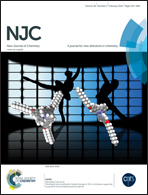Solvent switchable CuII complexes†
Abstract
A new tetranuclear complex Cu4, [Cu2L(OH)]2·2CH3OH·H2O (1), with the functionalized Schiff base ligand 2,6-bis((2-(acetylamino)phenylimino)methyl)-4-tert-butylphenol (H3L) has been obtained and characterized in the solid state by X-ray diffraction. The formation of the tetranuclear species is solvent dependent, the presence of water being a determinant in its isolation. Based on the mass-spectrometric evidence, the behaviour of the H3L–CuII system in the presence of water was investigated. Namely, water can switch the nuclearity of the CuII cluster from dinuclear to tetranuclear. The redox behaviour of this species in DMSO solution, showing two cathodic metal-centred peaks at EP = −0.80 and −1.35 V and an irreversible ligand-centred anodic peak at EP = 1.03 V, was found to be similar to that of a pristine dinuclear complex. The tetranuclear species was also characterized in the solid state by magnetic measurements, showing a dominating bulk antiferromagnetic behaviour, with a singlet ground state at approximately 2 K. DFT calculations permitted us to estimate the strong intradimer antiferromagnetic exchange interaction (J1 = −440 cm−1), together with two weak interdimer ferromagnetic exchange interactions (J2 = +0.5 and J3 = +1.7 cm−1).


 Please wait while we load your content...
Please wait while we load your content...